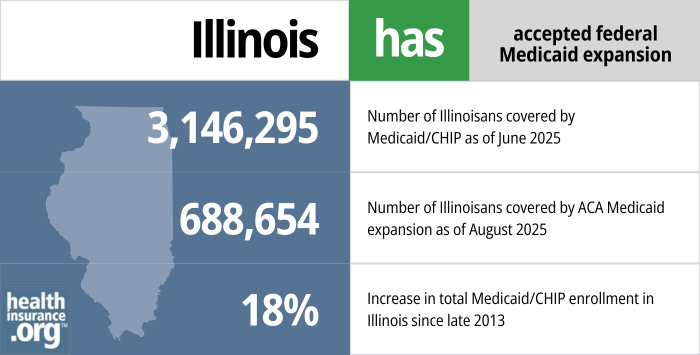
Medicaid eligibility and enrollment in Illinois
Nearly 700,000 people are covered under the state’s expansion of Medicaid

Who is eligible for Medicaid in Illinois?
Federal law specifies mandatory and optional coverage groups for Medicaid. States must cover the mandatory groups to receive federal Medicaid funding, and they qualify for additional funding if they cover optional groups. The federal government specifies minimum thresholds for eligibility for the various groups, and states can set their requirements at or above the minimum threshold. Illinois has established requirements that are near national averages.
Illinois’ eligibility standards for Medicaid are:1
- Children ages 0-18 qualify with family income levels up to 318% of the federal poverty level (FPL); the combined Medicaid/CHIP in Illinois is called All Kids.2
- Someone who is pregnant will qualify with family income up to 213% of FPL (coverage for the mother extends for 12 months after the baby is born;3 Illinois was the first state to implement this extended postpartum coverage, although most of the rest of the states have followed suit).4
- Adults under age 65 qualify with family income up to 138% of FPL. This is the Medicaid expansion program.
Note that all of those limits include a built-in 5% income disregard, which is part of the MAGI-based eligibility rules used to determine Medicaid eligibility for Medicaid expansion, pregnant people, and children.5
for 2026 coverage
0.0%
of Federal Poverty Level
Apply for Medicaid in Illinois
Apply online, or fill out an application and return it by mail or fax. You can also apply in person at the nearest Family Community Resource Center.
Eligibility: Children ages 0-18 with family income levels up to 142% of FPL. Pregnant women with family income up to 208% of FPL. Adults with family income up to 138% of FPL.



Is the ACA’s Medicaid expansion implemented in Illinois?
As of August 2025, there were 688,654 Illinois adults enrolled in the ACA’s expanded Medicaid, accounting for about 22% of the state’s total Medicaid population of nearly 3.2 million people.6
Total Medicaid enrollment includes people who are eligible under the ACA’s expansion of Medicaid to low-income adults, as well as people who were already in one of the traditional Medicaid groups (low-income people who are also either pregnant, children, parents of minor children, aged, blind, or disabled residents). Nearly four out of five Illinois Medicaid enrollees are in one of those traditional eligibility groups.
But for those eligible due to the ACA’s expansion of Medicaid, a work requirement will take effect in 2027 (or possibly later, as states are allowed to seek a delayed start), due to the “One Big Beautiful Bill” that was enacted in 2025.
- 3,146,295 – Number of Illinoisans covered by Medicaid/CHIP as of June 20257
- 688,654 – Number of Illinoisans covered by ACA Medicaid expansion as of August 20256
- 18% – Increase in total Medicaid/CHIP enrollment in Illinois since late 20138

Explore our other comprehensive guides to coverage in Illinois

Illinois runs a partnership exchange with the federal government. The state operates Get Covered Illinois, which has a website, in-person help, and a help desk,1 but Illinois residents use the federally-run HealthCare.gov platform to enroll in Affordable Care Act (ACA) Marketplace health plans.


Hoping to improve your smile? Dental insurance may be a smart addition to your health coverage. Our guide explores dental coverage options in Illinois.


Use our guide to learn about Medicare, Medicare Advantage, and Medigap coverage available in Illinois as well as the state’s Medicare supplement (Medigap) regulations.


Short-term health plans provide temporary health insurance for consumers who may find themselves without comprehensive coverage.

Frequently asked questions about Illinois Medicaid eligibility and enrollment
How do I enroll in Medicaid in Illinois?
You have several options to enroll in Medicaid in Illinois:
- Apply online using the Illinois website or Healthcare.gov (for non-disabled adults under age 65).
- Apply in person and get help from the Department of Human Services (DHS). Find the nearest Family Community Resource Center.
- Apply by mail or fax, or apply online or call at 1-800-843-6154 (TTY 1-800-447-6404) and ask DHS to mail you an application. Complete the application and mail or fax it back to the nearest Family Community Resource Center.
How does Medicaid provide assistance to Medicare beneficiaries in Illinois?
Many Medicare beneficiaries also receive assistance through Medicaid. This includes help with Medicare premiums, cost sharing, prescription drug costs, and services not covered by Medicare – such as long-term care expenses.
Our guide to financial resources for Medicare beneficiaries in Illinois describes these programs, including Medicare Savings Programs, Medicaid long-term care benefits, and guidelines for eligibility.
How did Illinois handle Medicaid renewals after the pandemic?
During the COVID pandemic, states were prohibited from disenrolling people from Medicaid, even if they no longer met the eligibility guidelines. This rule was in use for three years, from March 2020 through March 2023. But states have since resumed regular eligibility redeterminations and disenrollments.
States had some flexibility on the timing of the return to normal procedures, and Illinois opted to delay this as long as possible. The state began sending renewal notices in late April 2023, for people whose Medicaid was due to renew in June. The first round of disenrollments came on July 1 — three months after the earliest possible date allowed by the federal government.
Total Medicaid enrollment in Illinois peaked in July 2023, with just under 4 million people covered (this was about a million additional people, compared with pre-pandemic enrollment). Two years later, in August 2025, total enrollment stood at fewer than 3.2 million people.6
Many people who lost Medicaid during the post-pandemic “unwinding” process were eligible for employer-sponsored coverage or coverage in the Illinois Marketplace (HealthCare.gov, although Illinois will be running its own Marketplace enrollment platform, Get Covered Illinois, as of the fall of 2025).
According to CMS, more than 105,000 Illinois residents transitioned from Medicaid to a Marketplace plan during the “unwinding” of the pandemic-era continuous coverage rule.9
Legislation impacting Illinois Medicaid
Illinois Medicaid history
Medicaid was implemented in Illinois in January 1966.
Individuals covered by Medicaid in Illinois can choose either a fee-for-service plan or a managed care plan. The majority of Illinois Medicaid enrollees (2.5 million out of almost 3.2 million total enrollees) have managed care coverage.6
In June 2014, then-Governor Pat Quinn signed a Medicaid reform bill. The law restored adult dental care and podiatry services, aligns Illinois law with federal law to provide Medicaid coverage to children who have been without private insurance for three months, streamlines hospital and nursing-home reimbursement, and more.
In July 2013, Illinois opted to expand Medicaid eligibility, as allowed by the ACA, starting in January 2014. Making Medicaid available to low-income, non-elderly adults is a key part of the Affordable Care Act’s strategy to reduce the nation’s uninsured rate. However, a Supreme Court ruling made Medicaid expansion optional, and as of the fall of 2025, there were still 10 states that had not expanded Medicaid.10
Louise Norris is an individual health insurance broker who has been writing about health insurance and health reform since 2006. She has written hundreds of opinions and educational pieces about the Affordable Care Act for healthinsurance.org.

Looking for more information about other options in your state?
Need help navigating health insurance options in Illinois?
Explore more resources for options in IL including ACA coverage, short-term health insurance, dental and Medicare.
Speak to a sales agent at a licensed insurance agency.
Footnotes
- ”Medicaid, Children’s Health Insurance Program, & Basic Health Program Eligibility Levels” Medicaid.gov. Accessed Sep. 28, 2025 ⤶
- ”About All Kids” Illinois.gov. Accessed Sep. 28, 2025 ⤶
- ”Pritzker Administration Announces Illinois is First State to Extend Full Medicaid Benefits to Mothers 12 Months Postpartum” Illinois.gov. Apr. 13, 2021 ⤶
- ”Medicaid Postpartum Coverage Extension Tracker” KFF.org. Jan. 17, 2025 ⤶
- ”With respect to MAGI conversion, how will the 5% disregard be applied?” https://www.medicaid.gov/faq/2020-04-13/92591 Medicaid.gov. Accessed Sep. 28, 2025 ⤶
- ”Medical and Managed Care Enrollment By Month – August 2025” Illinois Department of Healthcare and Family Services. Data for August 2025, accessed Sep. 28, 2025 ⤶ ⤶ ⤶ ⤶
- ”June 2025 Medicaid & CHIP Enrollment Data Highlights“, Medicaid.gov, Accessed Sep. 28, 2025 ⤶
- “Total Monthly Medicaid & CHIP Enrollment and Pre-ACA Enrollment”, KFF.org, Accessed Sep. 28, 2025 ⤶
- ”HealthCare.gov Marketplace Medicaid Unwinding Report” Centers for Medicare & Medicaid Services. Data through April 2024; Accessed Dec. 29, 2024 ⤶
- ”Status of State Medicaid Expansion Decisions” KFF.org. Sep. 12, 2025 ⤶

